As an Amazon Associate KitchenwareSets.com earns from qualifying purchases.
11 Genius Stone Backsplash Kitchen Makeover Ideas
Is your kitchen the heart of your home, but the backsplash feels more like a forgotten relic from another decade? You’re not alone. That dated, boring, or simply uninspired wall between your countertops and cabinets can hold your entire kitchen’s style hostage, making a space you love feel lackluster and tired. You dream of a transformation, but the thought of a full-scale renovation can be overwhelming.
You see stunning kitchens online and in magazines, and a common thread is the timeless, elegant beauty of a natural stone backsplash. It seems like a premium upgrade, something that brings character, texture, and a touch of nature indoors. But you might be wondering if it’s a practical choice, how much work is involved, and which style would even fit your home.
A natural stone backsplash is a fantastic idea for a kitchen makeover because it is highly heat-resistant, incredibly durable, and adds significant resale value to your home. With a world of options from the classic elegance of marble to the rustic charm of slate, it has the unique power to completely transform any kitchen’s aesthetic from bland to breathtaking. This guide will walk you through 11 genius ideas to prove that a stunning stone backsplash is not just a dream, but an achievable reality for your kitchen.
Is Your Kitchen Backsplash Holding Your Style Hostage?
A natural stone backsplash is a great idea for a kitchen makeover because it’s highly heat-resistant, durable, and adds significant resale value. With options from classic marble to rustic slate, it can uniquely transform any kitchen’s aesthetic from bland to beautiful. Many homeowners feel their kitchen is dated but hesitate to make a change, worried about cost or complexity. Yet, installing a stone backsplash is one of the most impactful upgrades you can make. It’s a premium, yet achievable, solution that offers a powerful combination of durability, organic beauty, and lasting value. We’re about to unveil 11 distinct, genius ideas that prove there’s a perfect stone backsplash for every style and budget, empowering you to finally create the kitchen you’ve always wanted.
Why Choose a Natural Stone Backsplash? (The Benefits in a Nutshell)
Natural stone backsplashes offer key benefits like superior heat and moisture resistance, unmatched durability against scratches, a unique one-of-a-kind appearance for every slab, and an increase in your home’s overall resale value, making it a smart and stylish investment. Beyond just looking beautiful, these geological wonders are perfectly suited for the demanding environment of a kitchen.
- Durability: Natural stone is incredibly tough and resistant to scratches and dings from daily kitchen activities.
- Heat & Moisture Resistance: Formed by intense heat and pressure, stone can easily handle the heat from a cooktop and, when properly sealed, resists moisture.
- Unique Appearance: No two pieces of natural stone are exactly alike. Your backsplash will have unique veining, color, and character, making it a true one-of-a-kind feature.
- Design Versatility: From the polished elegance of marble to the rugged texture of slate, there is a stone to match any kitchen style—modern, rustic, traditional, and beyond.
- Increased Home Value: A high-quality stone backsplash is a premium feature that is highly attractive to potential buyers, often increasing the overall resale value of your home.
11 Genius Stone Backsplash Makeover Ideas for 2025
Ready for some serious inspiration? A stone backsplash isn’t a one-size-fits-all solution. The type of stone, the pattern, and the finish you choose can completely redefine your kitchen’s personality. We’ve curated a collection of 11 genius makeover ideas, blending current interior design trends with timeless architectural principles to help you find the perfect look for your home.
https://www.youtube.com/watch?v=-4bRSvn-cFA
Here are the top stone backsplash ideas to transform your kitchen in 2025:
- Classic Marble Elegance
- Rustic Slate Charm
- Warm Travertine Welcome
- Modern Full-Height Drama
- Textured Stacked Stone Feature
- Intricate Herringbone Pattern
- Earthy Limestone Subtlety
- Bold & Colorful Marble Statement
- Sleek Quartzite Sophistication
- Budget-Friendly Peel-and-Stick Stone
- Mixed Stone Mosaic Magic
1. Classic Marble Elegance for a Timeless Look
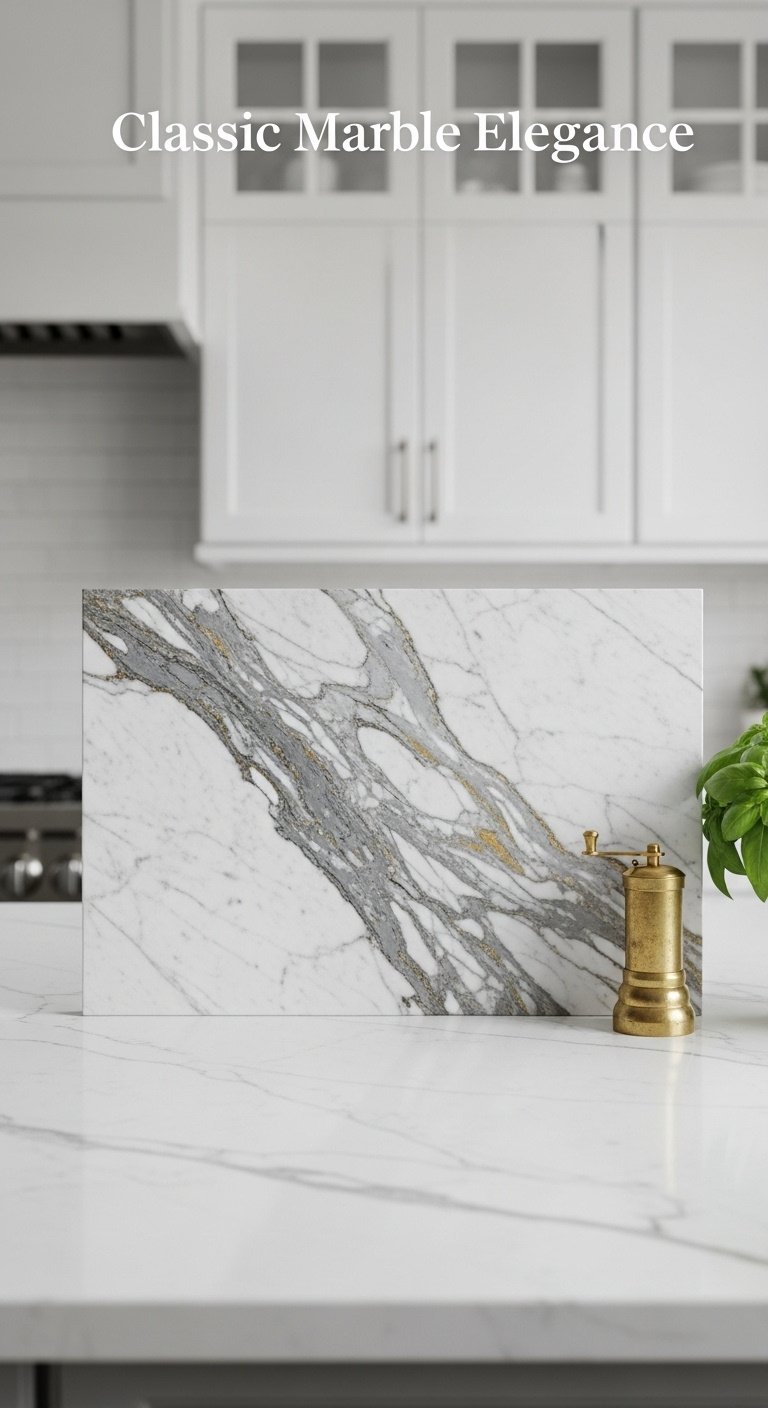
Marble is the undisputed champion of classic luxury, instantly elevating a kitchen with its bright surface and elegant veining. Whether you choose the dramatic grey veins of Calacatta or the softer, more subtle look of Carrara, a marble backsplash pairs beautifully with white shaker cabinets for a timeless look or navy blue cabinets for a sophisticated contrast.
- Materials Needed: Polished or honed marble tiles (e.g., 3×6 subway or larger format), white thin-set mortar, tile spacers, non-sanded grout (for polished marble), grout sealer, wet tile saw.
- Step-by-Step Directions:
- Clean and prep the wall surface, ensuring it’s smooth and level.
- Mix the thin-set mortar according to the manufacturer’s instructions.
- Apply a thin layer of mortar to the wall with a notched trowel.
- Press tiles into the mortar, using spacers for even grout lines. Make cuts with the wet saw as needed.
- Allow the mortar to cure for 24-48 hours.
- Remove spacers, apply grout, and clean off excess.
- After the grout cures, apply a quality stone sealer to protect against stains.
Pro-Tip: Always use a white thin-set mortar behind light-colored marble like Carrara. Gray mortar can sometimes bleed through and discolor the stone over time.
“Pin this timeless look to your ‘Dream Kitchen’ board!”
2. Rustic Charm with Textured Slate
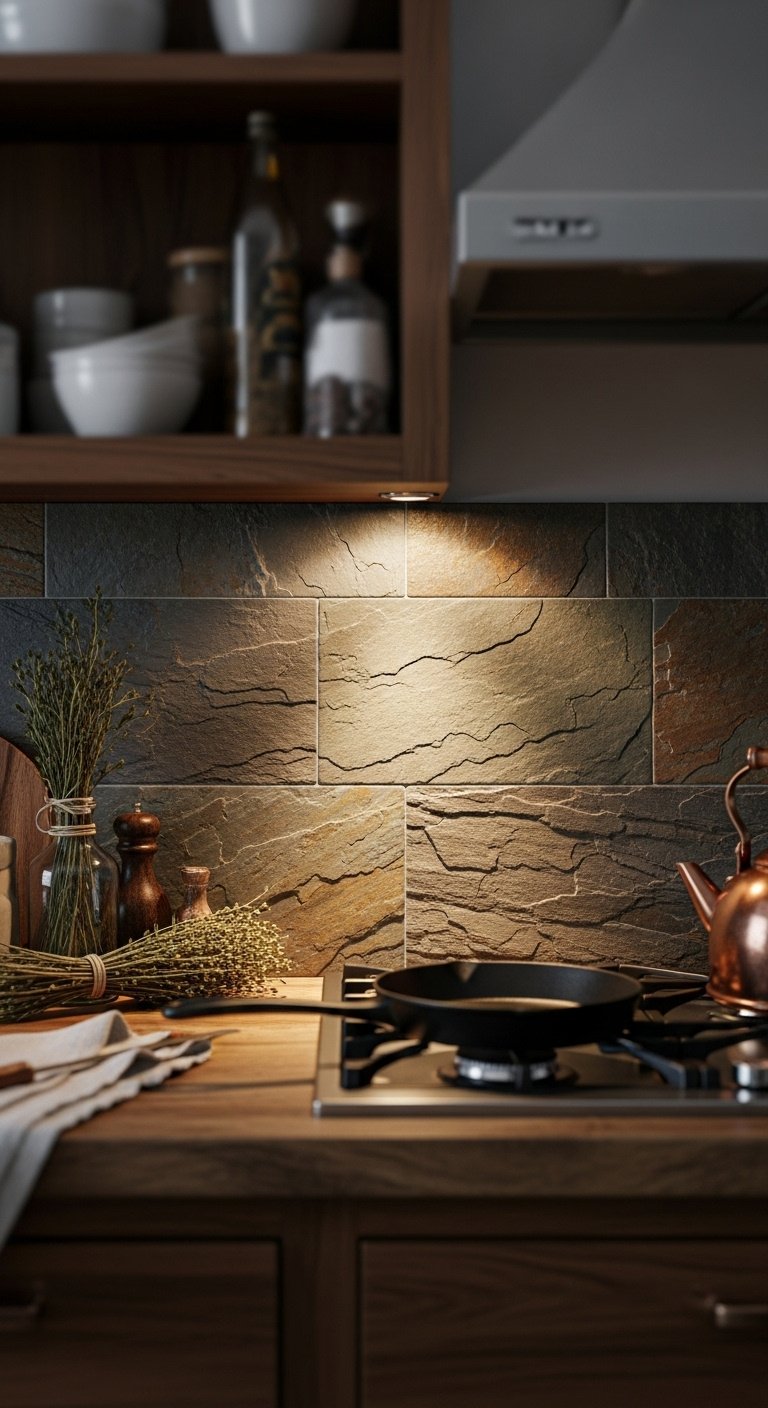
For a look that feels warm, organic, and grounded, a textured slate backsplash is a perfect choice for rustic and farmhouse kitchens. Its naturally cleft surface and deep, earthy tones of gray, green, and brown add incredible depth and character, pairing wonderfully with wood cabinets and countertops.
- Materials Needed: Natural slate tiles or ledger panels, polymer-modified thin-set mortar, grout (optional for stacked panels), tile sponge, penetrating stone sealer.
- Step-by-Step Directions:
- Ensure the wall is clean and can support the weight of the slate.
- Plan your layout, mixing tiles from different boxes to blend color variations.
- Apply mortar to the back of each tile (“back-buttering”) and press firmly onto the wall.
- For ledger panels, interlock the pieces for a seamless look.
- Wipe away any excess mortar immediately. Let it cure completely.
- Apply multiple coats of a high-quality penetrating sealer to enhance color and protect the porous surface.
Pro-Tip: When cleaning a textured slate backsplash, use a soft-bristled brush to gently scrub away grease from the crevices without damaging the stone’s surface.
“Love this look? Save it to your ‘Farmhouse Kitchen Inspiration’ board!”
3. The Warm Welcome of Tumbled Travertine
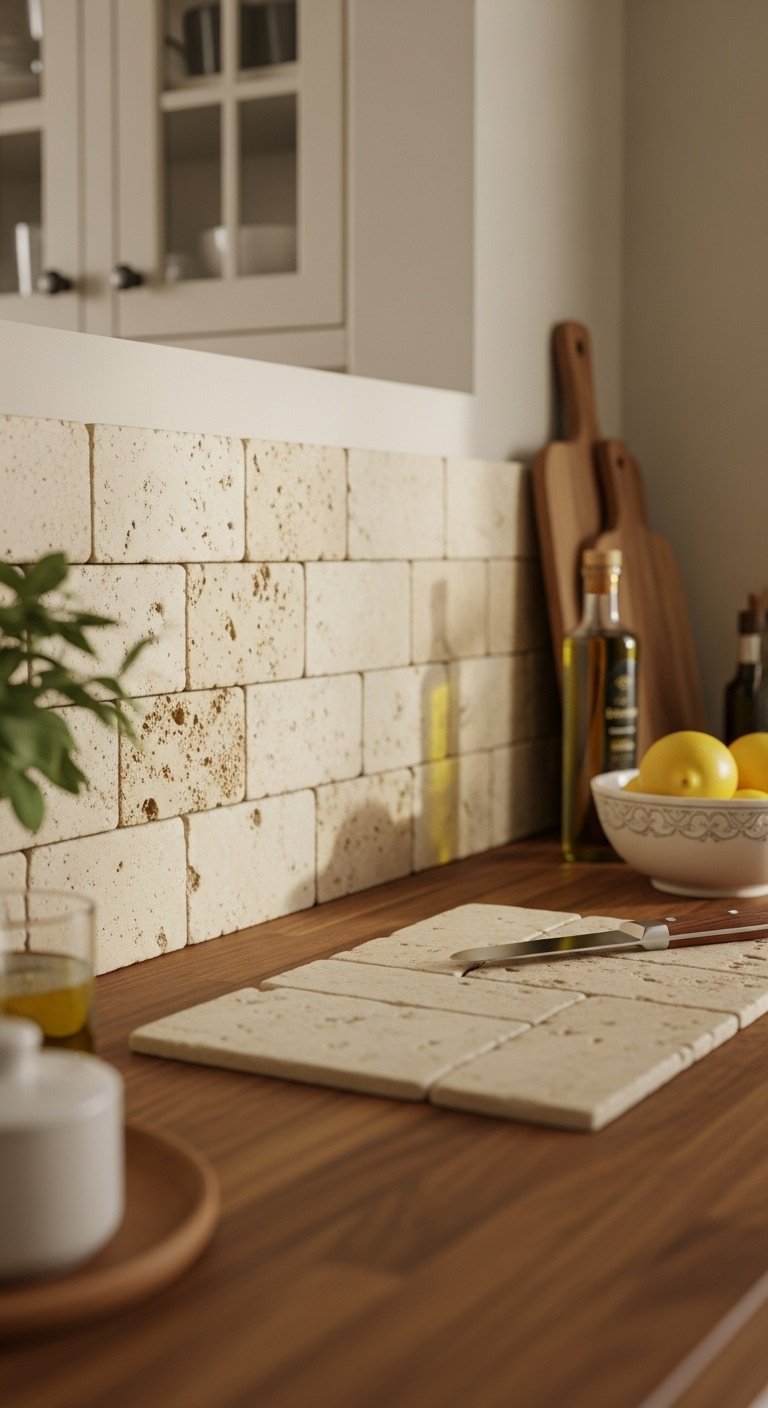
Tumbled travertine creates an inviting, sun-drenched feel reminiscent of a Mediterranean villa or a cozy European cottage. Its warm, creamy tones, soft edges, and characteristic pits give it a lived-in, aged charm that makes a kitchen feel instantly welcoming.
- Materials Needed: Tumbled travertine tiles (e.g., 4×4 or subway), mortar, sanded grout (to fill pits), grout release agent, enhancing sealer.
- Step-by-Step Directions:
- Prepare the wall surface. Apply a grout release agent to the face of the tiles before installation to make cleanup easier.
- Install the tiles using thin-set mortar and spacers.
- Let the mortar cure.
- Apply sanded grout, pushing it into the natural pits and crevices of the tumbled stone for a filled, classic look.
- Clean the surface thoroughly and let the grout cure.
- Apply an enhancing sealer to deepen the stone’s warm tones and provide protection.
Lesson Learned: Skipping a grout release agent on tumbled travertine is a common mistake. The porous surface will absorb grout haze, making it incredibly difficult to clean off later.
“Add this warm and cozy vibe to your ‘Kitchen Remodel’ board!”
4. Modern Drama with a Full-Height Backsplash
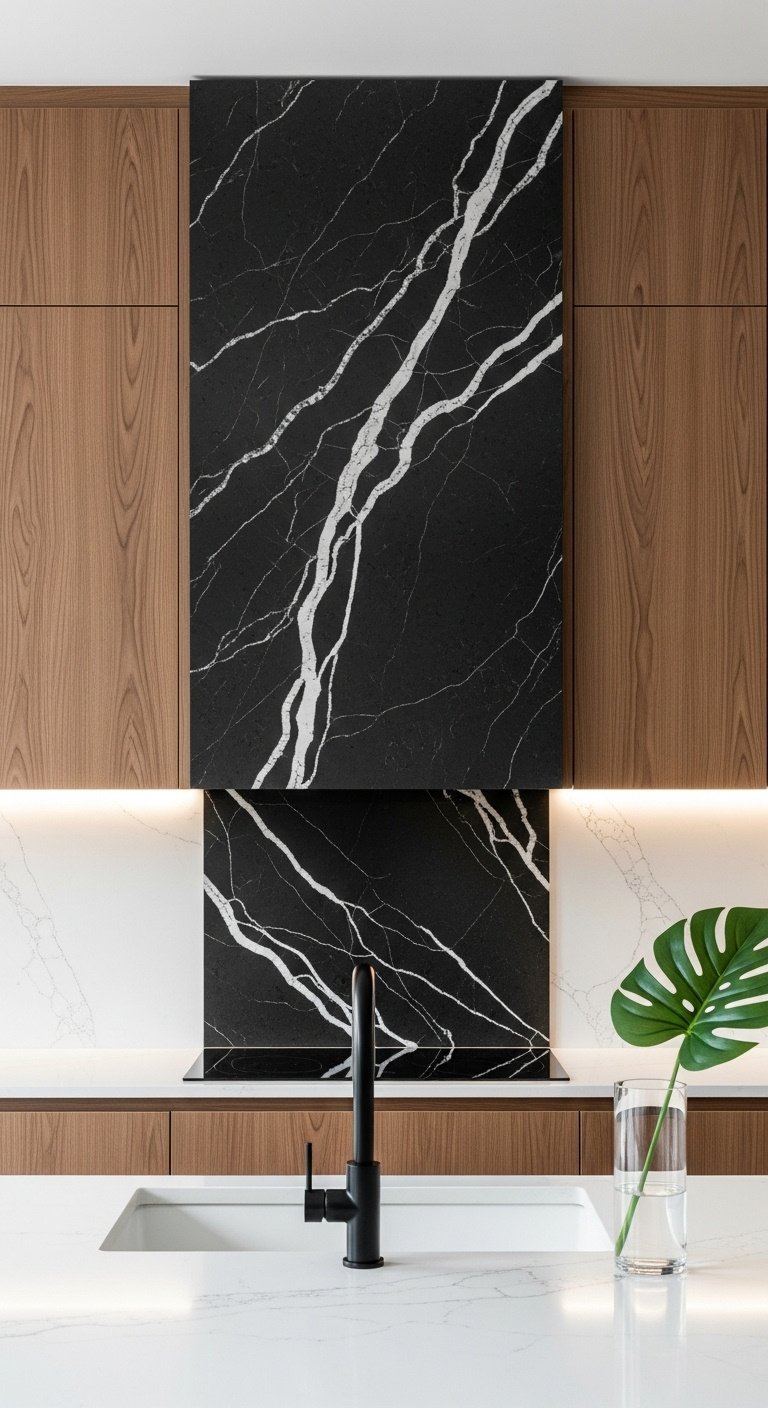
For a truly high-impact, luxurious statement, a full-height slab backsplash creates a seamless, grout-free wall of art that is undeniably modern and dramatic. Extending a single piece of stone like quartzite, granite, or marble from the countertop to the ceiling makes the space feel larger and incredibly sophisticated.
- Materials Needed: A large stone slab (granite, quartzite, or marble), heavy-duty construction adhesive specifically for stone, professional installation tools (this is typically not a DIY job).
- Step-by-Step Directions:
- Hire a Professional: This is critical. A full-height slab requires precise measurement, cutting for outlets, and specialized equipment to lift and install without cracking.
- Template Creation: Professionals will create a perfect template of your wall space.
- Fabrication: The slab is cut to the template’s specifications at a stone yard.
- Wall Preparation: The wall must be perfectly flat and primed.
- Installation: The slab is adhered to the wall using a strong adhesive and supported until it sets.
Pro-Tip: When choosing a slab for a full-height backsplash, ask to see the exact piece you’ll be getting. The veining on a large piece becomes a major art feature, so you want to love the pattern.
“Pin this high-impact design for your modern kitchen inspo!”
5. Add Tactile Depth with a Stacked Stone Feature
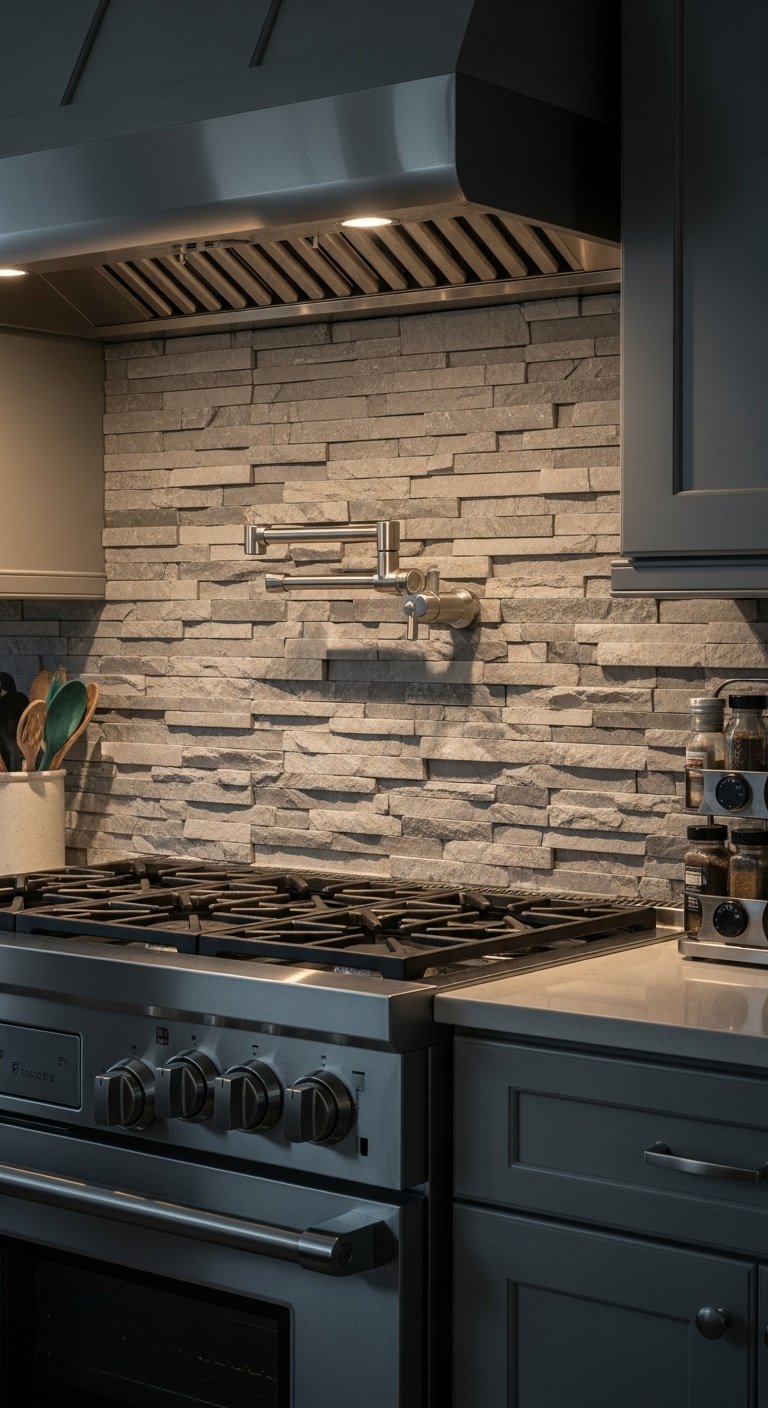
A stacked stone or rock backsplash adds unparalleled texture and a rugged, organic feel to a kitchen. Made of interlocking panels of stone veneer, this 3D backsplash creates a powerful focal point, especially behind a stove or as a feature wall.
- Materials Needed: Stacked stone ledger panels, polymer-modified mortar or construction adhesive, level, trowel.
- Step-by-Step Directions:
- Clean the wall and mark a level starting line.
- Mix and apply mortar to the wall or back-butter the panels.
- Press the first row of panels firmly onto the wall, ensuring it’s perfectly level.
- Work your way up, staggering the joints between panels for a natural look.
- Cut panels as needed to fit around outlets or corners using a wet saw with a diamond blade.
- No grouting is required for most stacked stone panels.
Lesson Learned: Stacked stone is notoriously difficult to clean. It’s best used as a feature wall away from the primary cooking “splash zone” or requires a commitment to cleaning with a brush. Sealing it can help, but won’t eliminate the issue entirely.
“Want to add texture? Pin this stacked stone idea now!”
6. Create Movement with a Stone Herringbone Pattern
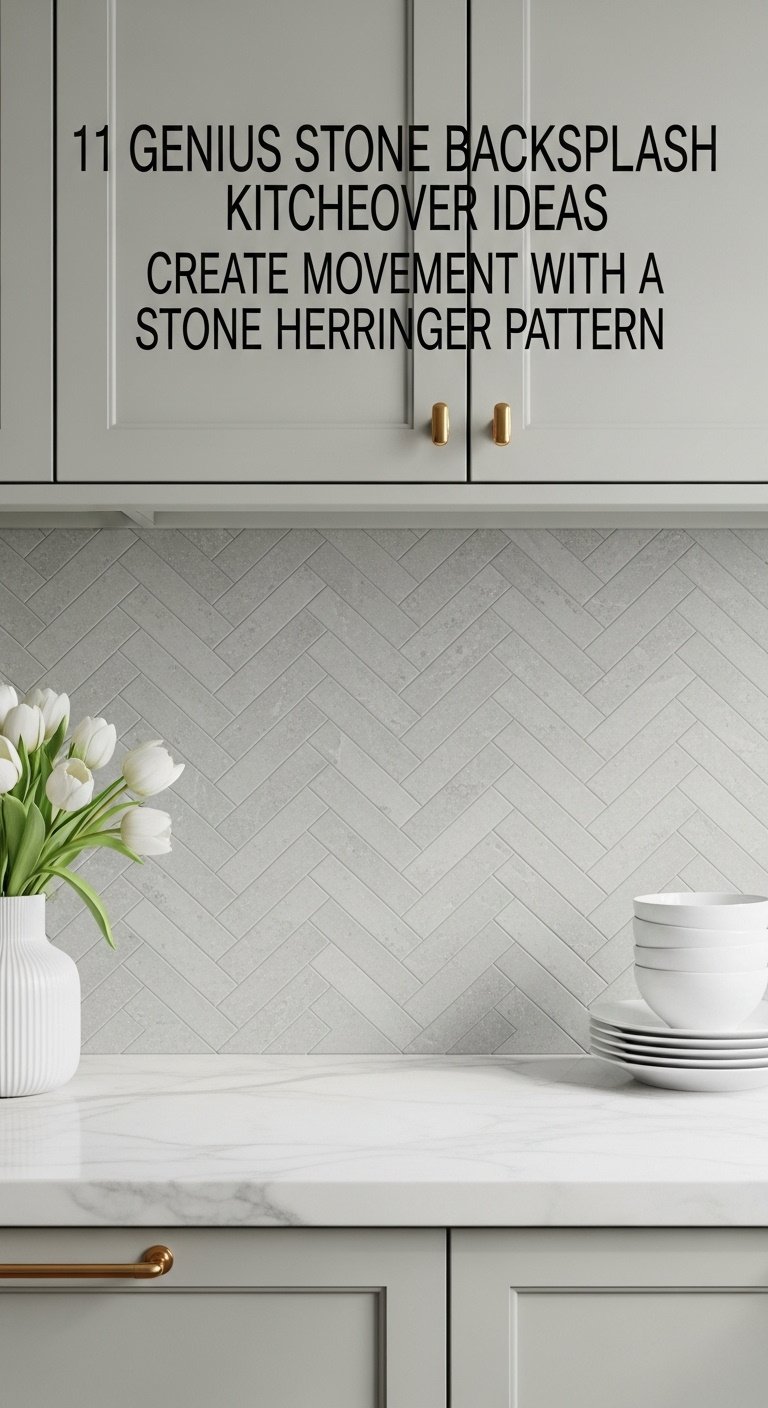
Using a classic herringbone pattern with stone tiles creates a sense of movement and visual interest that feels both sophisticated and dynamic. This layout works beautifully with rectangular tiles made from limestone, marble, or travertine, and it’s a signature of the modern farmhouse style.
- Materials Needed: Rectangular stone tiles (limestone, marble, or travertine), thin-set mortar, tile spacers for herringbone patterns, grout, tile saw.
- Step-by-Step Directions:
- Find the center of your backsplash area and draw a vertical reference line.
- Start your first tile at a 45-degree angle on this centerline to begin the “V” shape.
- Work outwards, interlocking the tiles in the herringbone pattern. This requires many angled cuts where the pattern meets the countertop and cabinets.
- Use tile spacers designed for herringbone to maintain consistency.
- Once all tiles are set and mortar is cured, grout the entire surface.
- Seal the stone and grout after curing.
Pro-Tip: A herringbone pattern results in more tile waste due to the numerous angle cuts. Always order at least 15-20% extra tile, compared to the standard 10% for a simpler pattern.
“Save this beautiful herringbone pattern for your next project!”
7. Understated Elegance with Soft Limestone
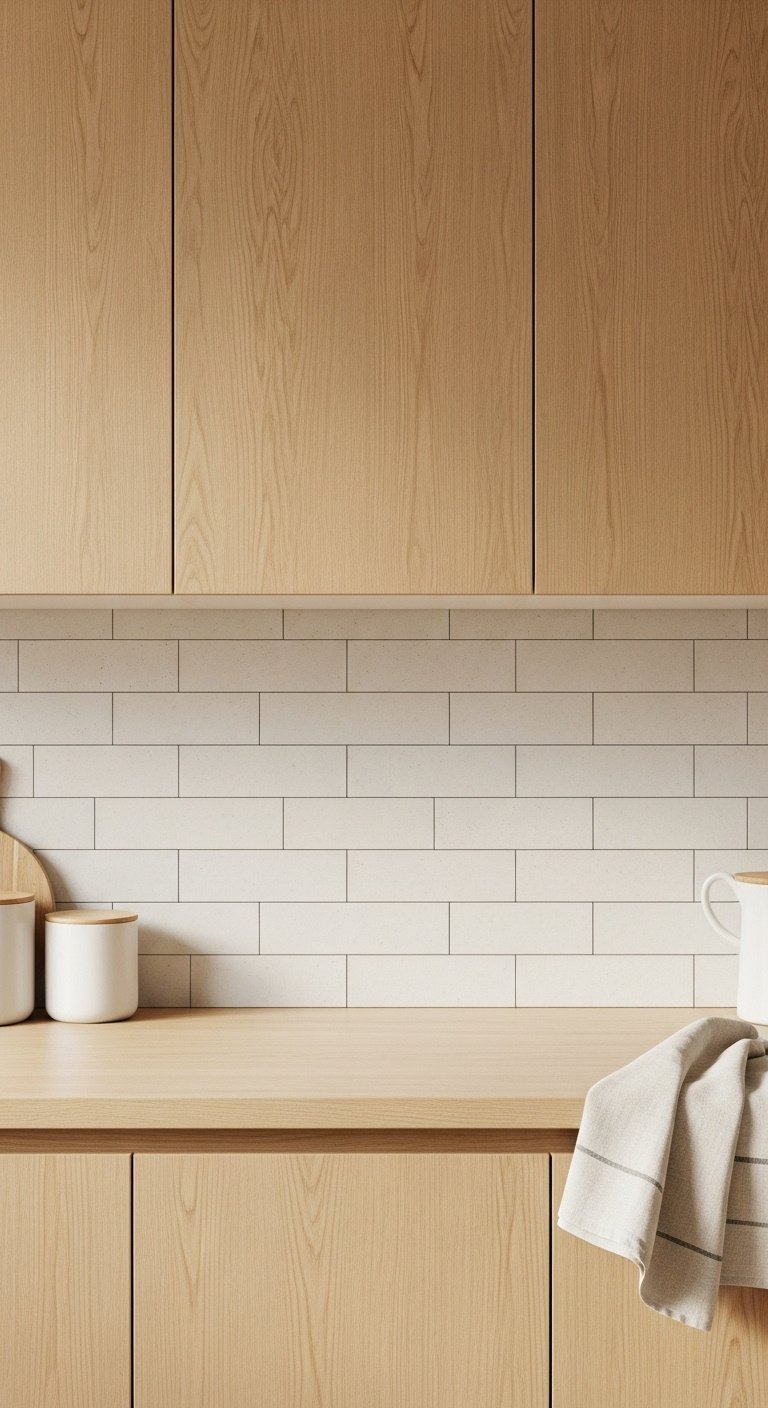
For a kitchen that whispers elegance rather than shouts it, a soft limestone backsplash provides a calm, neutral, and incredibly sophisticated backdrop. Its warm, creamy tones and subtle texture create a serene and timeless look without overwhelming the space, perfect for minimalist and organic modern designs.
- Materials Needed: Limestone tiles, pH-neutral stone cleaner, white thin-set mortar, tile spacers, non-sanded grout, high-quality impregnating sealer.
- Step-by-Step Directions:
- Clean the wall surface thoroughly.
- Install tiles using white thin-set mortar to prevent discoloration of the light stone.
- Limestone is very soft; handle and cut it carefully with a diamond blade wet saw.
- Grout with non-sanded grout to avoid scratching the tile surface.
- Crucially, apply several coats of an impregnating sealer before and after grouting, as limestone is highly porous and susceptible to stains.
Lesson Learned: Never clean limestone with acidic cleaners like vinegar or citrus-based products. They will etch and permanently dull the stone’s surface. Always use a pH-neutral cleaner.
“Pin this serene limestone look for a peaceful kitchen vibe.”
8. The Bold Statement of Colorful Marble

Move beyond the whites and grays to make a dramatic statement with a richly colored or boldly veined marble. Deep greens, dramatic blacks, or marbles with striking purple veining like Calacatta Viola can serve as the stunning centerpiece of your kitchen design.
- Materials Needed: Colored marble tiles or slab (e.g., Verde Green, Calacatta Viola), appropriate mortar, grout that complements the stone color, premium stone sealer.
- Step-by-Step Directions:
- Decide if you want a full backsplash or a framed feature behind the stove.
- For a feature, create a border with pencil liners or other trim pieces.
- Follow standard marble tile installation procedures (see idea #1), paying close attention to blending the veining between tiles for a cohesive look.
- If using a slab, this is a professional installation job.
- Sealing is non-negotiable to preserve the rich color and prevent etching.
Pro-Tip: When using a bold, colorful stone, let it be the star. Pair it with neutral cabinets and countertops (like simple white, black, or wood) to avoid a visually cluttered and overwhelming space.
“Dare to be bold? Pin this stunning green marble idea!”
9. Sleek & Strong with Polished Quartzite
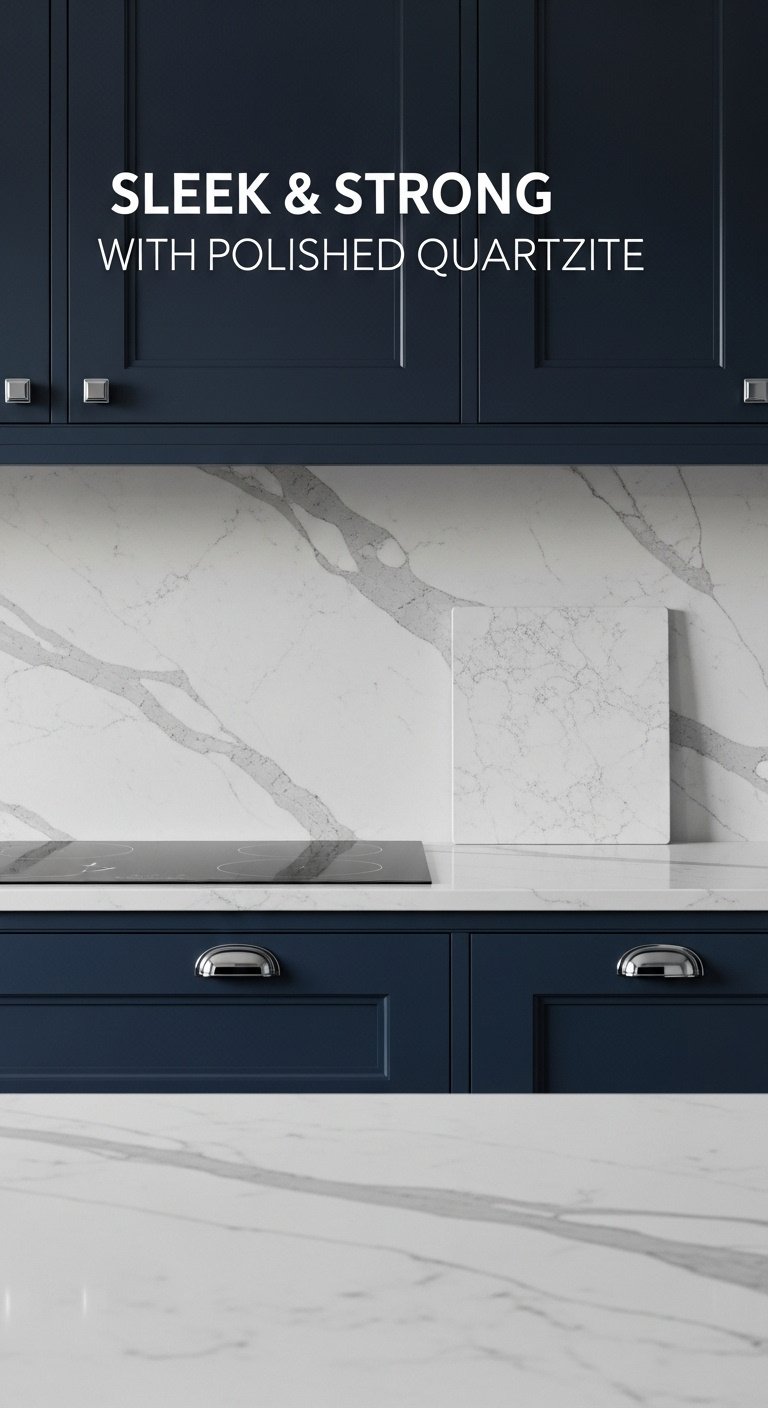
Quartzite offers the best of both worlds: the soft, elegant veining of marble combined with durability that is even greater than granite. This makes it an ideal choice for a low-maintenance yet incredibly beautiful modern stone backsplash that will stand the test of time.
- Materials Needed: Quartzite tiles or slab, thin-set mortar, grout, professional-grade sealer.
- Step-by-Step Directions:
- Quartzite is a natural stone (not to be confused with engineered quartz countertops) that is harder than granite. It requires a powerful wet saw with a high-quality diamond blade for cutting.
- Installation is similar to other natural stones. Ensure the wall is level and clean.
- Use spacers and apply with thin-set mortar.
- Grout the joints once the mortar has cured.
- Even though it’s very durable, quartzite is still porous and must be sealed properly to prevent staining.
Lesson Learned: Some stone suppliers mislabel marble as ‘soft quartzite.’ Perform a scratch test: try to scratch a sample with a piece of glass. True quartzite will scratch the glass. If the stone scratches, it’s likely marble.
“Get the look of marble without the worry! Pin this quartzite idea.”
10. The DIY Dream: Easy Peel-and-Stick Stone
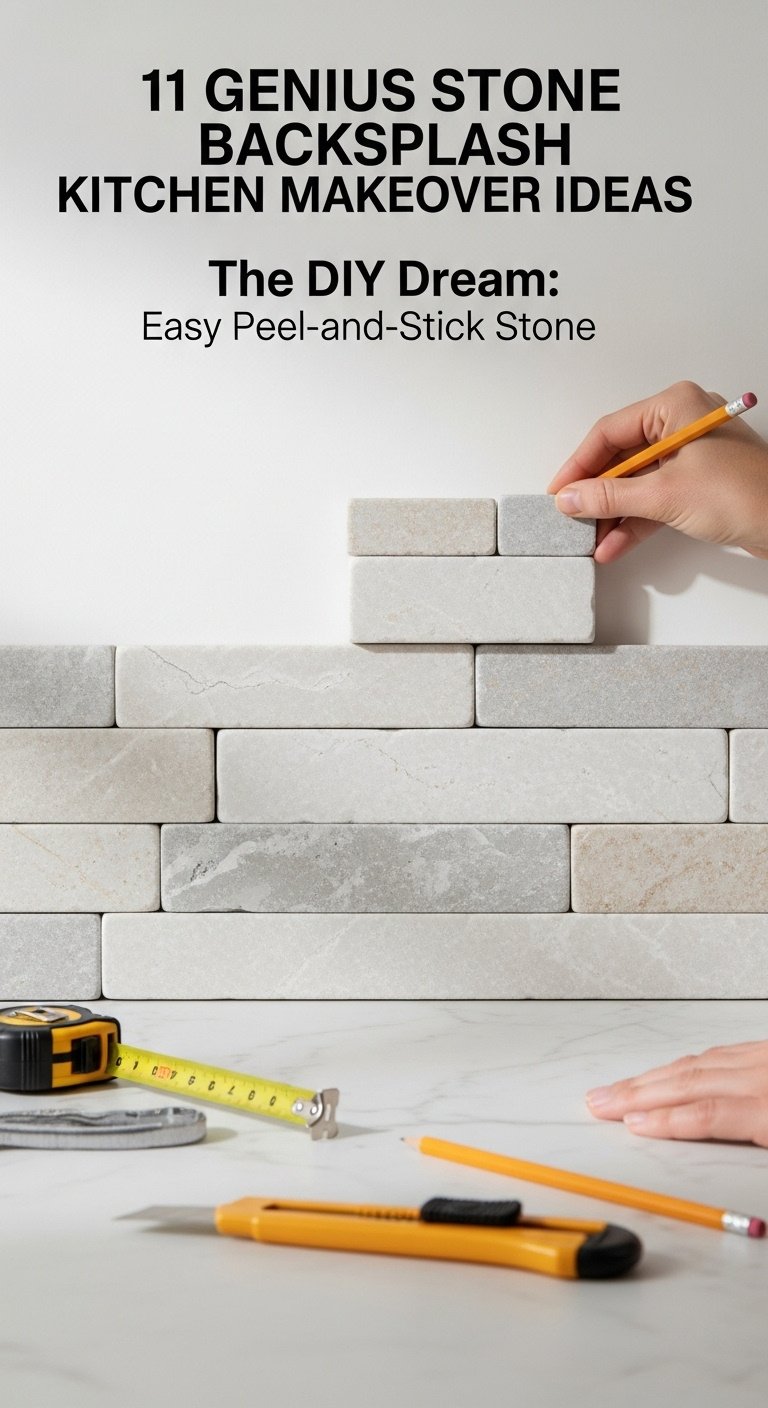
For a budget-friendly and beginner-friendly weekend project, peel-and-stick tiles made from thin-cut, genuine stone offer an amazing solution. These lightweight panels provide the authentic texture and look of stone without the need for messy mortar or grout, making a kitchen update easier than ever.
- Materials Needed: Peel-and-stick stone tile panels, utility knife or tin snips, level, measuring tape, pencil, degreasing cleaner.
- Step-by-Step Directions:
- Thoroughly clean your existing wall with a degreaser to ensure the adhesive sticks properly. The wall must be smooth and dry.
- Measure your space and plan your layout.
- Measure and mark your tiles for any necessary cuts.
- Use a sharp utility knife (scoring and snapping) or tin snips to cut the tiles.
- Peel the backing off the first tile and press it firmly onto the wall, starting in a corner.
- Overlap the tiles according to the manufacturer’s instructions to create a seamless look.
Pro-Tip: Before you peel the backing, do a ‘dry fit’ of your first row and any tricky corner pieces. This allows you to perfect your cuts and alignment without wasting any adhesive tiles.
“Your weekend project is here! Pin this easy DIY backsplash.”
11. Artistic Flair with Mixed Stone Mosaics
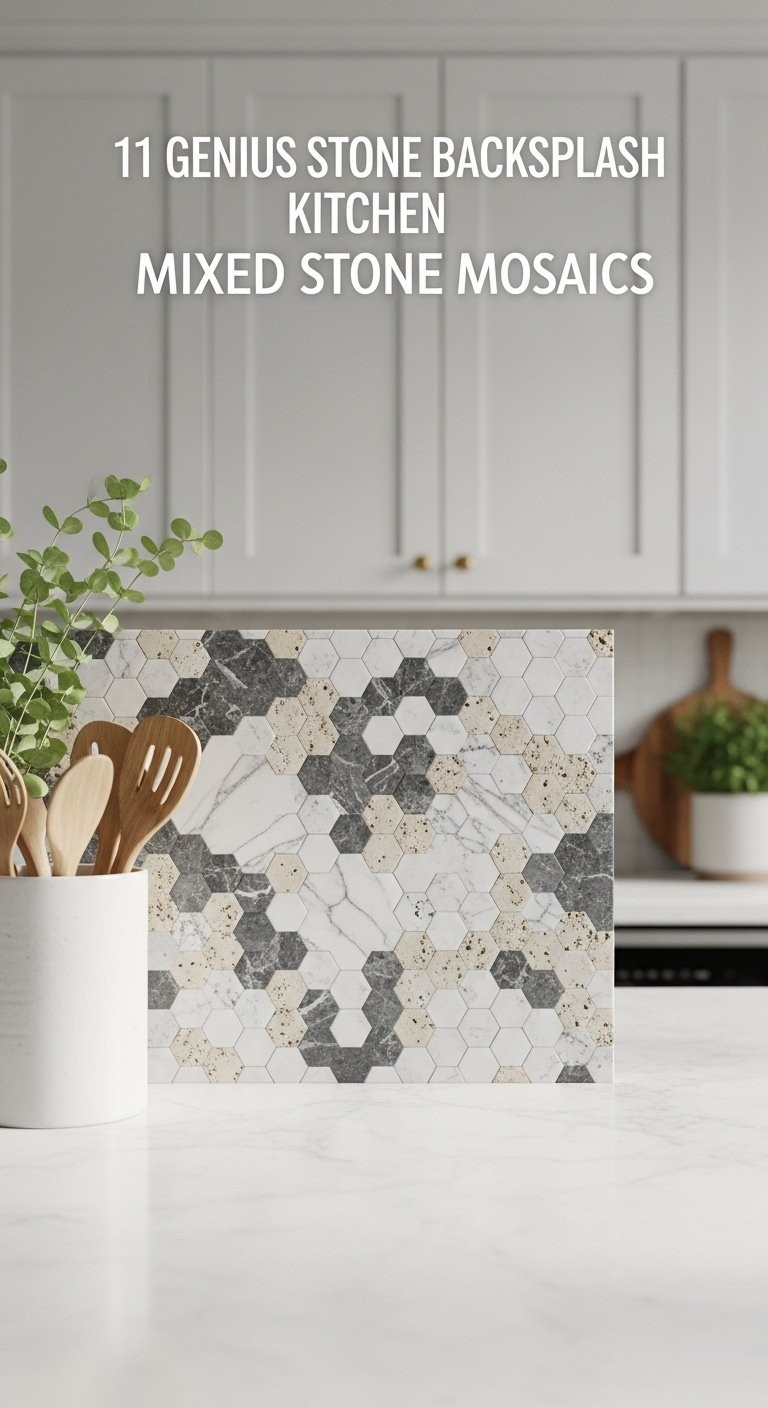
Unleash your creative side with a mosaic stone backsplash that introduces intricate patterns and a mix of textures and colors. Whether it’s classic penny rounds, trendy hex tiles, or a custom pattern, mesh-backed mosaic sheets make it easy to install a detailed, artistic design that adds a unique personality to your kitchen.
- Materials Needed: Mesh-backed mosaic sheets (penny rounds, hex, etc.) made of mixed stone (marble, limestone, travertine), thin-set mortar, grout (sanded or unsanded based on joint size), grout float, sponge.
- Step-by-Step Directions:
- Prepare the wall surface.
- Apply a layer of thin-set mortar to a small section of the wall.
- Press the mosaic sheet into the mortar, using a grout float or clean piece of wood to gently tap it and ensure even adhesion.
- Connect subsequent sheets, ensuring the pattern lines up seamlessly.
- After the mortar cures, apply grout over the entire surface, pressing it into the joints.
- Clean the excess grout off the tile faces with a damp sponge.
- Seal the entire backsplash after the grout is fully cured.
Lesson Learned: When installing mesh-backed mosaics, check for sagging. After placing a sheet, step back and look. If individual tiles are drooping, use a small tool to push them back into place before the mortar sets.
“Unleash your inner artist! Save this mosaic idea to your ‘Kitchen Design’ board.”
Key Takeaways: Your Quick Guide to a Stunning Stone Backsplash
Feeling inspired? Here are the most important things to remember as you plan your kitchen transformation.
- Match Stone to Style: Use sleek marble or quartzite for modern looks, and textured slate or travertine for rustic/farmhouse styles.
- Consider Maintenance: Polished, single-slab backsplashes are easiest to clean. Textured and heavily pitted stones like slate and travertine require more maintenance and careful sealing.
- Pattern Adds Personality: Simple subway patterns are timeless, while herringbone or mosaics create a dynamic focal point.
- Don’t Fear DIY: Options like peel-and-stick stone make a weekend transformation possible for any skill level.
- Always Seal Natural Stone: This is a non-negotiable step to protect your investment from stains and moisture, regardless of the stone type.
People Also Ask About Stone Kitchen Backsplashes
Is a stone backsplash a good idea?
Yes, a stone backsplash is an excellent idea for most kitchens. It is highly durable, resistant to heat from cooktops, and adds a timeless, high-end look that can increase home value. While it requires sealing to prevent stains, its longevity and unique beauty make it a worthwhile investment.
What is the trend in kitchen backsplash in 2025?
The top kitchen backsplash trend for 2025 is the “slab backsplash,” where a single, seamless piece of stone (like marble or quartzite) extends from the counter to the cabinets or ceiling. Also popular are textured stones like slate and limestone, as well as earthy, nature-inspired colors and patterns.
Should your backsplash be lighter or darker than your countertop?
There’s no strict rule, but a common design choice is to create contrast. A darker backsplash can create a dramatic focal point against light countertops. Conversely, a lighter backsplash can brighten the space and make it feel larger, especially when paired with dark countertops.
Is it cheaper to do quartz backsplash or tile?
Generally, a tile backsplash is cheaper than a quartz slab backsplash. The cost of individual tiles and installation materials (mortar, grout) is typically lower than the price of fabricating and installing a large, solid piece of quartz. However, tile installation can be more labor-intensive.
Final Thoughts
A stone backsplash is so much more than a functional wall covering—it’s a statement. It’s a piece of natural art that brings millions of years of history and character into the heart of your home. Whether you choose the sleek drama of a full slab or the rustic charm of stacked slate, the right stone has the power to completely redefine your kitchen and how you feel in it.
Now that you’re armed with these ideas, which stone backsplash style speaks to you the most? Let us know in the comments below
